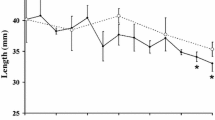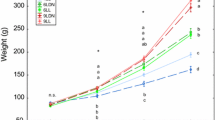Abstract
The effect of different light regimes on the development of sexual maturity and body composition (carbon, nitrogen, lipid and protein) of Antarctic krill, Euphausia superba, was studied over 12 weeks under laboratory conditions. Krill were exposed to light-cycle regimes of variable intensity to simulate Southern Ocean summer, autumn and winter conditions, respectively using: (1) continuous light (LL; 200 lux max), (2) 12-h light and 12-h darkness (LD 12:12; 50 lux max), and (3) continuous darkness (DD). The sexual maturity of female and male krill exposed to LL and LD 12:12 showed an accelerated succession of external maturity stages during the experimental period, while krill exposed to continuous darkness showed no changes in external maturity during the course of the study. Changes in the maturity development of krill between the different light regimes are reflected in changes in body composition. Krill exposed to LL and LD 12:12 showed an increase in lipid utilization, indicating that the development of external maturation may be fuelled preferentially by lipid reserves. In contrast, values of total lipid content of krill held under continuous darkness indicated an unchanged lipid catabolism during the course of the study. Thus, the maturity development of krill was affected either directly or indirectly by the different simulated light conditions. Based on these results, and observations on the effects of simulated light regimes on feeding and metabolic rates of krill available from a previous study, we suggest that the Antarctic light regime is an essential cue governing the seasonal cycle of krill physiology and maturity, and highlight the importance of this environmental factor in the life history of krill.






Similar content being viewed by others
References
Anger K, Harms J (1990) Elemental (CHN) and proximate biochemical composition of decapod crustacean larvae. Comp Biochem Physiol 97B:69–80
Atkinson A, Snÿder R (1997) Krill-copepod interactions at South Georgia, Antarctica, I. Omnivory by Euphausia superba. Mar Ecol Prog Ser 160:63–76
Atkinson A, Meyer B, Bathmann U, Stübing D, Hagen W, Schmidt K (2002) Feeding and energy budget of Antarctic krill Euphausia superba at the onset of winter. II. Juveniles and adults. Limnol Oceanogr 47:953–966
Balzer I, Espinola IR, Fuentes-Pardo B (1997) Daily variations of immunoreactive melatonin in the visual system of crayfish. Biol Cell 89:539–543
Bargmann HE (1945) The development and life-history of adolescent and adult krill Euphausia superba. Dis Rep 23:103–176
Buchholz F, Saborowski R (2000) Metabolic and enzymatic adaptations in northern krill, Meganyctiphanes norvegica, and Antarctic krill, Euphausia superba. Can J Fish Aquat Sci (Suppl 3):115–129
Cullen M, Kaufmann RS, Lowery MS (2003) Seasonal variation in biochemical indicators of physiological status in Euphausia superba from Port Foster, Deception Island, Antarctica. Deep-Sea Res II 50:1787–1798
Cuzin-Roudy J (2000) Seasonal reproduction, multible spawning, and fecundity in northern krill, Meganyctiphanes norvegica, and Antarctic krill, Euphausia superba. Can J Fish Aquat Sci (Suppl 3):6–15
Denys CJ, Mcwhinnie MA (1982) Fecundity and ovarian cycles of the Antarctic krill Euphausia superba (Crustacea, Euphausiacea). Can J Zool 60:2414–2423
Hagen W, Van Vleet ES, Kattner G (1996) Seasonal lipid storage as overwintering strategy of Antarctic krill. Mar Eciol Prog Ser 134:85–89
Hagen W (2000) Lipids. In: Harris RP, Wiebe PH, Lenz J, Skjoldal HR, Huntley M (eds) ICES Zooplankton Methodology Manual. Academic press, NY, pp 113–119
Hagen W, Kattner G, Terbrüggen A, Van Vleet ES (2001) Lipid metabolism of the Antarctic krill Euphausia superba and its ecological implications. Mar Biol 139:95–104
Hardeland R, Poeggeler B (2003) Non-vertebrate melatonin. J Pineal Res 34:233–241
Hirano Y, Matsuda T, Kawagushi S (2003) Breeding antarctic krill in captivity. Mar Fresh Behav Physiol 36:259–269
Kawaguchi S, Candy SG, King R, Naganobu M, Nicol S (2006a) Modelling growth of Antarctic krill. I. Growth trends with sex, length, season, and region. Mar Ecol Prog Ser 306:1–15
Kawaguchi S, Yoshida T, Finley L, Cramp P, Nicol S (2006b) The krill maturity cycle: a conceptual model of the seasonal cycle in Antarctic krill. Polar Biol. doi:10.1007/s00300-006-0226-2
Lowry OH, Rosebrough NJ, Farr AL, Randall RJ (1951) Protein measurement with the Folin phenol reagent. J Biol Chem 193:265–275
Makarov RR (1975) A study of the second maturation of euphausiid (Eucarida, Euphausiacea) females (in Russian). Zoologicheskiy Zhurnal 54:670–681
Makarov RR, Denys CJ (1981) Stages of sexual maturity of Euphausia superba Dana. BIOMASS Handbook 11:1–13
Mauchline J (1980) Measurement of body length of Euphausia superba Dana. BIOMASS Handbook 4
Meyer B, Saborowski R, Atkinson A, Buchholz F, Bathmann U (2002) Seasonal differences in citrate synthase and digestive activity in larval and postlarval Antarctic krill, Euphausia superba. Mar Biol 141:855–862
Quetin LB, Ross RM (1991) Behavioural and physiological characteristics of the Antarctic krill, Euphausia superba. Am Zool 31:49–63
Ross RM, Quetin LB (2000) Reproduction in Euphausiacea. In: Everson I (ed) Krill biology, ecology and fisheries. Blackwell Cambridge, pp 150–181
Siegel V (1988) A concept of seasonal variation of krill (Euphausia superba) distribution and abundance west of the Antarctic Peninsula. In: Sahrhage D (ed) Antarctic Ocean and resources variability. Springer, Berlin, Heidelberg, New York, pp 219–230
Teschke M, Kawaguchi S, Meyer B (2007) Simulated light regimes affect feeding and metabolism of Antarctic krill, Euphausia superba. Limnol Oceanogr 52:1046–1054
Thomas PG, Ikeda T (1987) Sexual regression, shrinkage, re-maturation and growth of spent female Euphausia superba in the laboratory. Mar Biol 95:357–363
Tilden AR, Alt J, Brummer K, Groth R, Herwig K, Wilson A, Wilson S (2001) Influence of photoperiod on N-acetyltransferase activity and melatonin in the fiddler crab Uca pugilator. Ge Comp Endocrinol 122:233–237
Vivien-Roels B, Pévet P (1993) Melatonin: presence and formation in invertebrates. Experientia 49:642–647
Acknowledgements
This work was conducted at the Australian Antarctic Division (AAD) within the scope of the project “Experiments on live Krill” and was part of the collaborative research agreement between the AAD and the Alfred Wegener Institute for Polar and Marine Research. The authors thank all krill scientists and staff of the AAD for their hospitality and support during our visit. We also thank R. King and T. Yoshida for their professional and friendly support in the aquarium, and S. Nicol for constructive comments on the earlier version of the manuscript. Thanks to W. Hagen and D. Stübing for the introduction to lipid analyses and S. Spahić and C. Lorenzen for their help in the laboratory. The experiments conducted during this study comply with the current laws of Australia and was conducted under the auspices of AAS Project 2337. This work was funded by the German Academic Exchange Service (DAAD).
Author information
Authors and Affiliations
Corresponding author
Additional information
Communicated by M. Wahl.
Rights and permissions
About this article
Cite this article
Teschke, M., Kawaguchi, S. & Meyer, B. Effects of simulated light regimes on maturity and body composition of Antarctic krill, Euphausia superba . Mar Biol 154, 315–324 (2008). https://doi.org/10.1007/s00227-008-0925-z
Received:
Accepted:
Published:
Issue Date:
DOI: https://doi.org/10.1007/s00227-008-0925-z




